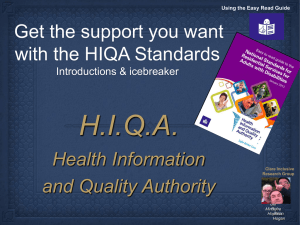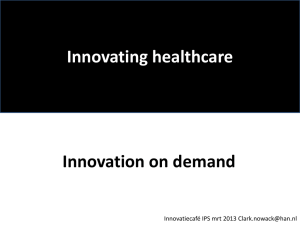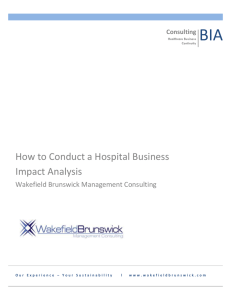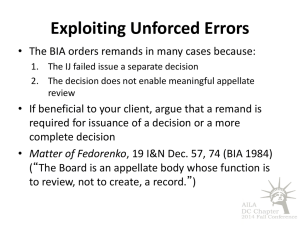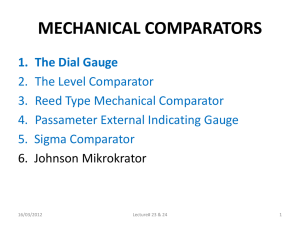BIA_ ISQua webinar_December 2013
advertisement
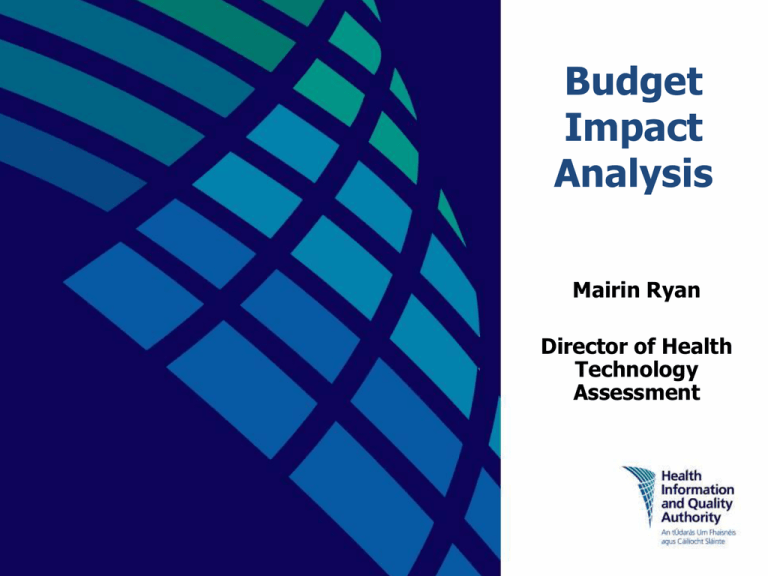
Budget Impact Analysis Mairin Ryan Director of Health Technology Assessment Budget Impact Analysis Science Patient wishes Industry claims Decision making “HTA is a decision support tool” Multidisciplinary process, summarises information about – Safety – Clinical and cost-effectiveness – Budget impact – Organisational impact / resource implications – Social and ethical issues related to use of a health technology in a systematic, transparent, unbiased and robust manner Budget Impact Analysis • Tool to predict the financial impact of the adoption and diffusion of a new technology into a healthcare system with fixed resources • Addresses affordability • Analysis of the added financial impact of a new health technology for a finite period of time Health Technologies Any intervention used to promote health, diagnose or treat disease, or used in rehabilitation or long-term care, e.g. Drugs Medical devices Diagnostics Surgical procedures Organisational & support systems Why conduct BIA? • Required to make an informed reimbursement decision – New technology may have increased acquisition costs – New technology may have cost-offsets e.g. Adverse effects, inpatient days – New technology may have different impact on different cost centres e.g. drug costs, laboratory costs, staff costs, Issues to consider in BIA • • • • • Perspective Technology Comparator Timeframe Target population • • • • • Costing Outcomes BIA Model Uncertainty Reporting Perspective • Perspective: viewpoint from which study is conducted e.g. payer, health sub-budget, society – Payer perspective considers costs falling on health (and social) care system only – Only costs falling on e.g. drugs budget – Societal perspective considers other costs e.g. Cost of accessing healthcare, Lost productivity due to accessing healthcare or ill health, unemployment benefits, income taxation Technology • Sufficient information to differentiate from comparators – Treatment indication – How it will be used, – What benefits it will deliver, – What else is needed to enable use e.g. healthcare staff, training requirements, adjunctive interventions, healthcare setting, capital investment Comparator • Preferred comparator is “routine care” – Technology most commonly used for that indication in your healthcare setting – More than one comparator (weighted average) – Comparator may include technology without marketing authorisation for that indication (must have efficacy and safety evidence) – No intervention may be appropriate choice Timeframe • Represents the time horizon over which resource use will be planned e.g. 5 years – Time to “steady state” depends on rate of diffusion or uptake of the technology – Slow diffusion may be due to capacity issues, learning curves – Long time to peak effect with chronic diseases, screening programmes, vaccinations etc. – Need to consider technological issues e.g. battery replacement etc. Target population • Individuals with a given condition who might avail of the technology within the time horizon – Epidemiology to inform reporting of prevalence, incidence, mortality (open cohort) – Report absolute size of target population – Estimate uptake based on proportion suitable for intervention, adherence and persistence data, market analysis, expert opinion – Report frequency of healthcare use e.g. episodes of care – Subgroups Costing • Costs included depend on perspective – Direct medical costs – Indirect medical costs – Indirect non-medical costs • Three steps to estimate cost – Identify resource use that may change – Quantify extent of changes – Measure costs of changes Resource use • Costs directly associated with intervention plus adjunctive interventions e.g. concomitant meds, adverse events, administration costs (staff, setting), • Cost offsets include reduced adjunctive interventions, reduced healthcare consumption • Costs not directly related to intervention excluded e.g. other healthcare costs due to extension of life Quantify resource use changes • Depict treatment sequence / clinical care pathway • Trial & observational data • Expert opinion Costs – Unit cost databases, administrative databases, microcosting analyses focussing on changes in resource use – Unit cost inflation (consumer price index) – Costs from other country (purchasing power parity) – Capital costs e.g. equipment, ICT, accommodation, maintenance (depreciation) – Staff costs e.g. mid point of scale, include administrative and pension overheads Clinical outcomes • Relevant outcomes are those which influence use of technology (effectiveness, safety, uptake, etc) and need for further treatment ( e.g. implantable device failure requiring further surgery) – Effectiveness: RCT data, meta-analysis, observational data – Safety: RCT, patient registries. All AEs of economic significance included e.g. Hospitalisation, impact on adherence, persistence etc. Why clinical outcomes? • Need to determine use of technology and any cost offsets • Provide data for planning resource use e.g. Reduced bed days • Data on benefits to justify budget increases BIA model • Structure of model described • All assumptions in model stated and sources acknowledged • Validation described • Model Baseline Scenario and New Technology Scenario • Static model • Dynamic model e.g. adjusted Costeffectiveness model (population size, VAT, discount rate) Budget Impact Analysis What is the difference between BIA and economic evaluation? Parameter BIA Economic evaluation Underlying concept Affordability Value for money Purpose Financial impact of introducing a technology Efficiency of alternative technologies Study timeframe Usually short-term (1 to 5 years) Usually long-term (e.g. lifetime) Health outcomes Excluded Quality adjusted life years Discounting No 4% Result Total and incremental annual costs Incremental cost per unit of health outcome achieved Uncertainty • Scenario analysis to evaluate plausible scenarios • Sensitivity analysis to evaluate uncertainty in budget estimates due to uncertainty in model and in key parameters Uncertainty (ctd) • Parameters to be examined: population size, uptake, costs (intervention and offsets) • Univariate sensitivity analysis • Multivariate sensitivity analysis • Probabilistic sensitivity analysis Reporting • Report resource use for each year in natural units • Disaggregated costs each year • Report total and incremental costs for each year • Report disaggregated by subgroup if appropriate • Report scenario and sensitivity analysis including range for each parameter Reporting Budget Impact B Comparator / routine practice Choice A Intervention Compares Robotic Hysterectomy versus mix of Laparoscopic plus Open Hysterectomy Year Costs A Costs B • Incremental budget impact: Costs A – Costs B Incremental budget impact 1 Median €0.49m (95% CI) (0.39 – 0.61) 2 €0.81m (0.69 – 0.95) 3 €0.95m (0.82 – 1.11) 4 €1.08m (0.92 – 1.26) 5 €1.15m (0.93 – 1.40) Total €4.48m (3.95 – 5.14) Univariate sensitivity analysis for incremental budget impact of robotic hysterectomy Volume of operations Operative time Equipment Robot lifespan Length of stay Per diem Robot maintenance 3.75 4.00 4.25 4.50 4.75 Five year budget impact (€m) 5.00 5.25 Budget impact of National Deep Brain Stimulation Programme Year 1 2 3 4 5 Irish service (€m) Current service (€m) Difference (€m) Cumulative difference(€m) 1.21 (0.93-1.67) 0.85 (0.62-1.20) 0.37 (0.07-0.71) 0.37 (0.07-0.71) 1.22 (0.93-1.68) 0.85 (0.62-1.21) 0.37 (0.07-0.72) 0.73 (0.13-1.41) 1.23 (0.93-1.70) 0.86 (0.63-1.23) 0.37 (0.07-0.72) 1.10 (0.20-2.13) 1.23 (0.93-1.72) 0.86 (0.62-1.24) 0.37 (0.06-0.72) 1.47 (0.26-2.85) 1.24 (0.93-1.74) 0.87 (0.62-1.25) 0.37 (0.06-0.73) 1.84 (0.32-3.55) Increased resource requirements by year for selected resources Resource Year 1 2 3 4 5 Consultant neurosurgeon (hrs) 334 344 352 355 365 Consultant neurologist (hrs) 218 214 211 210 206 Specialist nurse (hrs) 270 274 277 278 281 Theatre time (hrs) 111 112 112 113 113 Surgical bed days 225 226 227 228 228 Outpatient appointments 74 78 81 82 86 CT scans 30 31 31 31 31 MRI scans 35 35 35 35 35 Contribution of cost elements to cost per patient in the proposed Irish service 2.6% 21.0% Staff 1.2% Anaesthetic Per diem Operative cost 13.0% 62.2% Imaging Contribution of each procedure to the budget impact Initial assessment (PD) Initial assessment (ET & dystonia) Proposed Irish service Device implantation Device removal Battery replacement Device programming Current service Interim review Major review (PD) 0 1 2 3 4 Cost (€ million) 5 6 Major review (ET/dystonia) Conclusions • Budget impact analysis is important for reimbursement decisions • Data used in CEA and BIA models • Necessary to report total and incremental budget impact • Standardised approach allows meaningful comparisons • Methods used should be clearly explained and sufficient data provided to allow validation References • Guidelines for the Budget Impact Analysis of Health Technologies in Ireland 2013. www.hiqa.ie • Budget impact analysis – Principles of Good Practice: Report of the ISPOR 2012 Budget Impact Analysis Good Practice II Task Force www.ispor.org • Health Technology Assessment of robot-assisted surgery in Ireland. HIQA 2011. www.hiqa.ie • Health Technology Assessment of a Deep Brain Stimulation Service in Ireland. HIQA 2012. www.hiqa.ie Thank you mryan@hiqa.ie


